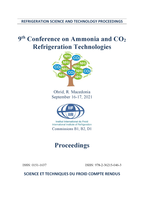
Recommended by the IIR / IIR document
Low charge ammonia systems designed as direct expansion.
Number: 0006
Author(s) : ELSTROM M.
Summary
Requirements to reduce global warming (GWP) and CO2 emissions lead to an increased desire for use of natural refrigerants. It is now possible to design Ultra Low Charge dry expansion systems, safer and more energy efficient than conventional DX, flooded and pump circulation systems. The desire to use the world’s most energy-efficient refrigerant, ammonia, in DX-designed refrigeration systems has led to many challenges and has rightfully earned the reputation of being a poor solution that does not always work well. There have been many problems, and over time, many attempts have been made without any significant breakthroughs. It was necessary to compromise the normal DX design and install liquid separators before the compressors and set superheating very high in order to avoid liquid flood-back and potential compressor damage. Inefficient/non-dynamic evaporators, poor compressor capacity control combined with ammonia’s high latent heat of vaporization have caused most of the challenges.
Available documents
Format PDF
Pages: 9
Available
Public price
20 €
Member price*
Free
* Best rate depending on membership category (see the detailed benefits of individual and corporate memberships).
Details
- Original title: Low charge ammonia systems designed as direct expansion.
- Record ID : 30028943
- Languages: English
- Source: 9th IIR Conference on Ammonia and CO2 Refrigeration Technologies. Proceedings: Ohrid, North Macedonia, 16-17 September, 2021
- Publication date: 2021/09/16
- DOI: http://dx.doi.org/10.18462/iir.nh3-co2.2021.0006
Links
See other articles from the proceedings (31)
See the conference proceedings
Indexing
-
Themes:
Ammonia;
Evaporators, condensers and other heat exchangers - Keywords: Ammonia; R717; Evaporator; Low charge; Low GWP; Cold storage; Australia; Case study; Direct expansion
-
Highly efficient large ammonia systems with ver...
- Author(s) : VESTERGAARD N. P., SKOVRUP M. J., KRISTOFERSSON J.
- Date : 2022/06/13
- Languages : English
- Source: 15th IIR-Gustav Lorentzen Conference on Natural Refrigerants (GL2022). Proceedings. Trondheim, Norway, June 13-15th 2022.
- Formats : PDF
View record
-
Comparison of a conventional flooded evaporator...
- Author(s) : ABBAS A., AYUB Z., AYUB A., et al.
- Date : 2019/08/24
- Languages : English
- Source: Proceedings of the 25th IIR International Congress of Refrigeration: Montréal , Canada, August 24-30, 2019.
- Formats : PDF
View record
-
Multi-objective optimization of low charge liqu...
- Author(s) : KAERN M. R., MARKUSSEN W. B., KRISTOFERSSON J.
- Date : 2019/04/11
- Languages : English
- Source: 8th Conference on Ammonia and CO2 Refrigeration Technology. Proceedings: Ohrid, North Macedonia, Avril 11-13, 2019.
- Formats : PDF
View record
-
Numerical analysis of flow maldistribution in l...
- Author(s) : KÆRN M. R., MARKUSSEN W. B., KRISTOFERSSON J.
- Date : 2020/12/07
- Languages : English
- Source: 14th IIR-Gustav Lorentzen Conference on Natural Refrigerants (GL2020). Proceedings. Kyoto, Japon, December 7-9th 2020.
- Formats : PDF
View record
-
Compact, energy efficient, low charge ammonia e...
- Author(s) : CHRISTENSEN R., SOLLIE B.
- Date : 2011/04/14
- Languages : English
- Source: 4th Conference on Ammonia Refrigeration Technology. Proceedings: Ohrid, North Macedonia, April 14-16, 2011.
- Formats : PDF
View record
